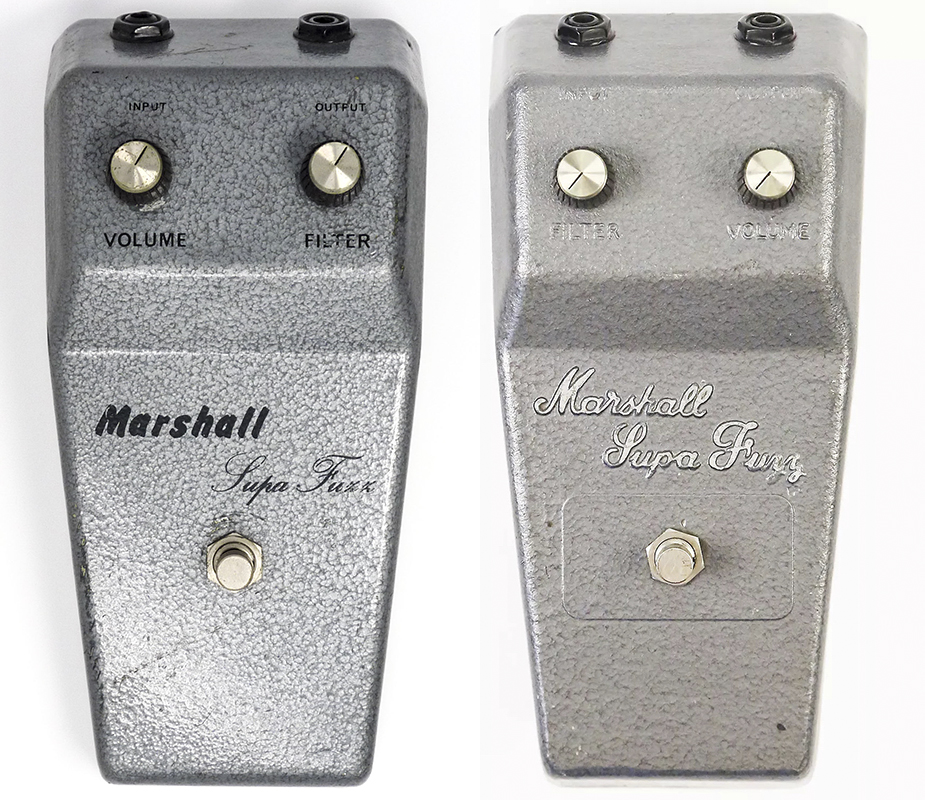- History
- 1966: ‘SupaFuzz MKI’ circuit
- 1966: ‘Big M’ SupaFuzz
- 1966-1968: Tone Bender MKII circuit
- 1968-c. 1973: Marshall’s version
- Share your fuzz!
History
Marshall was one of a handful of companies with whom Sola Sound had agreements in place to build fuzz boxes. Early SupaFuzz pedals were supplied to Marshall by Sola Sound, and these were being built & sold at roughly the same time that Sola Sound had also begun to mass-produce their famous Tone Benders in 1966. Marshall’s dealings with Sola Sound would continue until 1968, at which point Marshall went on to begin manufacturing the SupaFuzz themselves.
The SupaFuzzes that were built by Sola Sound can be recognised by their more angular enclosure, with sharper edges than Marshall’s version. According to Gary Hurst, the sloping sides of the early SupaFuzz were inspired by the enclosures of Olivetti adding machines that he’d seen in Italy.1
Beat Instrumental reported the SupaFuzz as “brand new” in February 1967, but the unit had evidently been available for quite some time already, as Jeff Beck was filmed with one in October of 1966, for the Yardbirds’ scene in the 1966 film, ‘Blow-up’.2
The earliest SupaFuzzes can be identified by the fact that the ‘volume’ & ‘filter’ controls are positioned slightly closer together, towards the centre of the face of the pedal. Early SupaFuzzes (manufactured by Sola Sound) also came equipped with gold-topped control knobs, as used by Marshall on their own amplifiers.
At some point, in 1966, Sola Sound updated the cast enclosures for the various different fuzz boxes that they were manufacturing, and the updated version of the SupaFuzz enclosure (c. late 1966) featured the two controls in their more familiar position.
It is the earlier version of the SupaFuzz that would be pictured in many of Marshall’s 1960s-era catalogues and advertisements, despite having only been in production for a relatively short period of time.
1966: ‘SupaFuzz MKI’
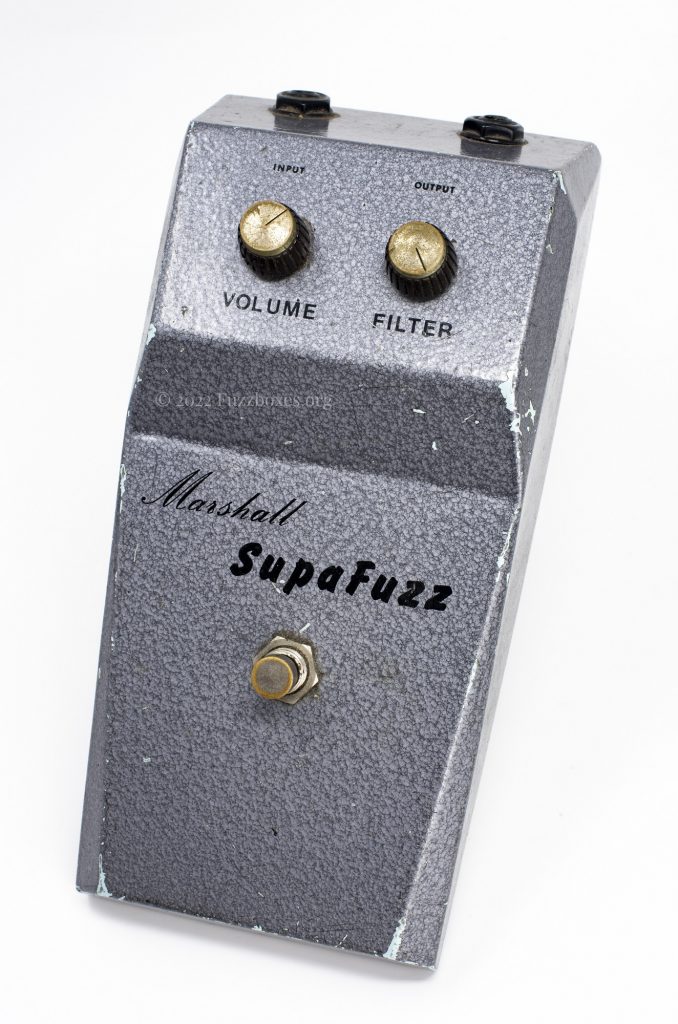


A popular talking point about the Marshall SupaFuzz is that, throughout both Sola Sound’s and also Marshall’s periods of producing the fuzz box, the control labelled ‘filter’ is actually a misnomer. Typical SupaFuzzes built by Sola Sound between 1966 and 1968, and also by Marshall, from 1968 until the mid-1970s, feature a three-transistor Tone Bender MKII circuit. This means that the ‘filter’ control on those SupaFuzzes was the same as the ‘attack’ control on a Tone Bender MKII, rather than a tone filter.
The reason, however, that Sola Sound & Marshall printed the SupaFuzz with the misnomer of a ‘filter’ control was that for a very brief period in 1966, the SupaFuzz did in fact feature a filter control. Some of the earliest SupaFuzzes were built with a version of the Tone Bender ‘MKI’ circuit, with the amount of fuzz fixed at maximum, and the secondary control functioned as a basic tone filter to reduce the amount of treble content. This short-lived version of the Marshall SupaFuzz is nowadays dubbed by collectors as the ‘SupaFuzz MKI’
This early version of the SupaFuzz was initially described by collectors as a “prototype”, due to to the perceived scarcity of them. The ‘SupaFuzz MKI’ is, however, nowadays agreed to have been a standard production model (albeit for a rather limited time). At the time of writing, there are already a dozen known surviving examples of the ‘SupaFuzz MKI’.
The ‘SupaFuzz MKI’ was likely one of Gary Hurst’s designs. According to Hurst, its filter control was intended “to make [the SupaFuzz] different to the Tone Bender”.3
Sola Sound’s and Marshall’s continued printing of the ‘filter’ label on their later versions of the SupaFuzz was purely an anachronism, which referred to this specific earlier version of the fuzz box.
1966: ‘Big M’ SupaFuzz
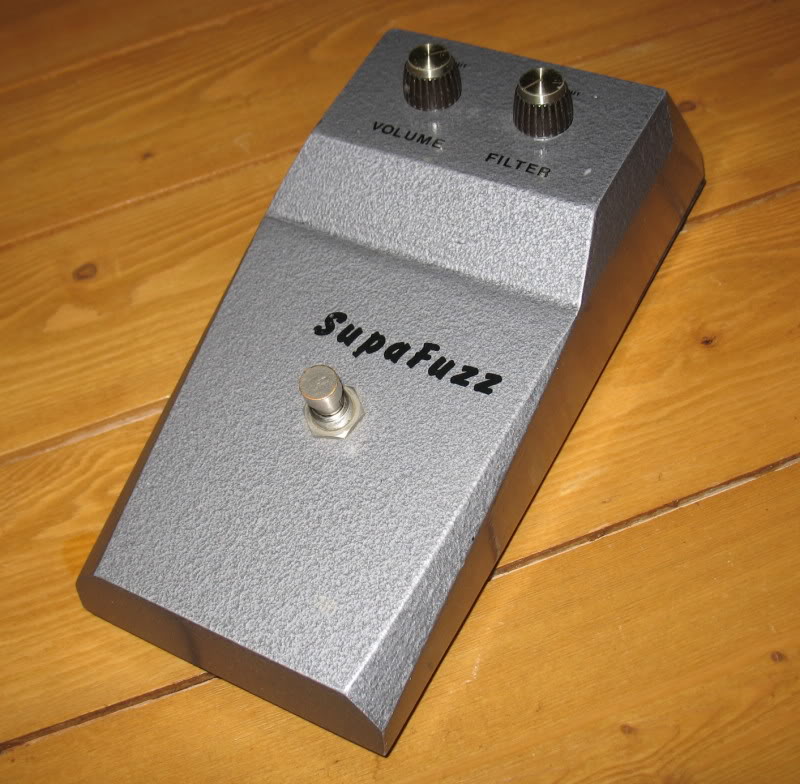


A number of very early SupaFuzzes, all of which having been built with this ‘SupaFuzz MKI’ circuit, were apparently sold in continental Europe. Interestingly, a significant number of those that have resurfaced there, have come with the ‘Marshall’ brand name either removed or masked off.
The pedal pictured above was unearthed in Germany, and is identical to the 1966 Marshall SupaFuzz ‘MKI’ pedals, other than that the Marshall brand has been removed or omitted from its enclosure. (Photo credit: S. Castledine)
These unbranded SupaFuzz pedals were likely to have been distributed in countries where Marshall didn’t have the authority to sell equipment under their own name. This was the case with the series of ‘Big M’ series of amplifiers that were built by Marshall, and sold internationally, and indeed, ‘Big M’ SupaFuzzes were listed in a Swedish catalogue.
Unbranded SupaFuzzes may have also been supplied to & distributed by companies other than Marshall, because a nondescript ‘SupaFuzz’ was also named in a German Vox price list.
‘Big M’ & unbranded SupaFuzz pedals, like the unit pictured above, were also pictured in several British advertisements and catalogues during the 1960s. A selection of these can be seen below.

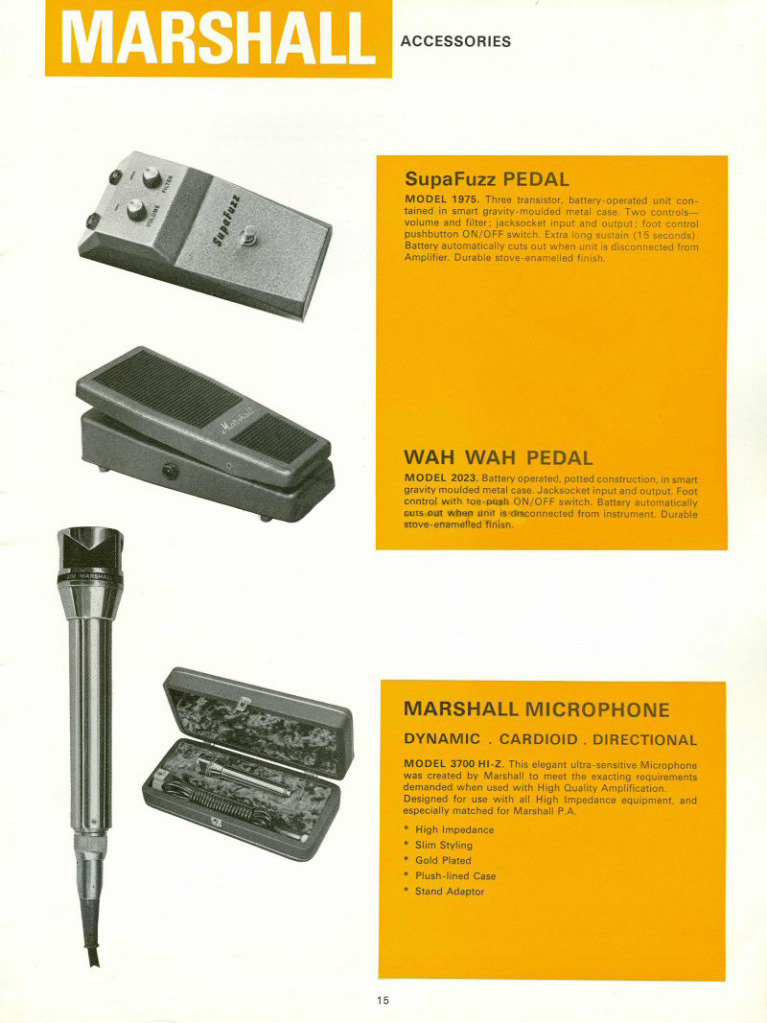
1966-1968: Tone Bender MKII, and beyond
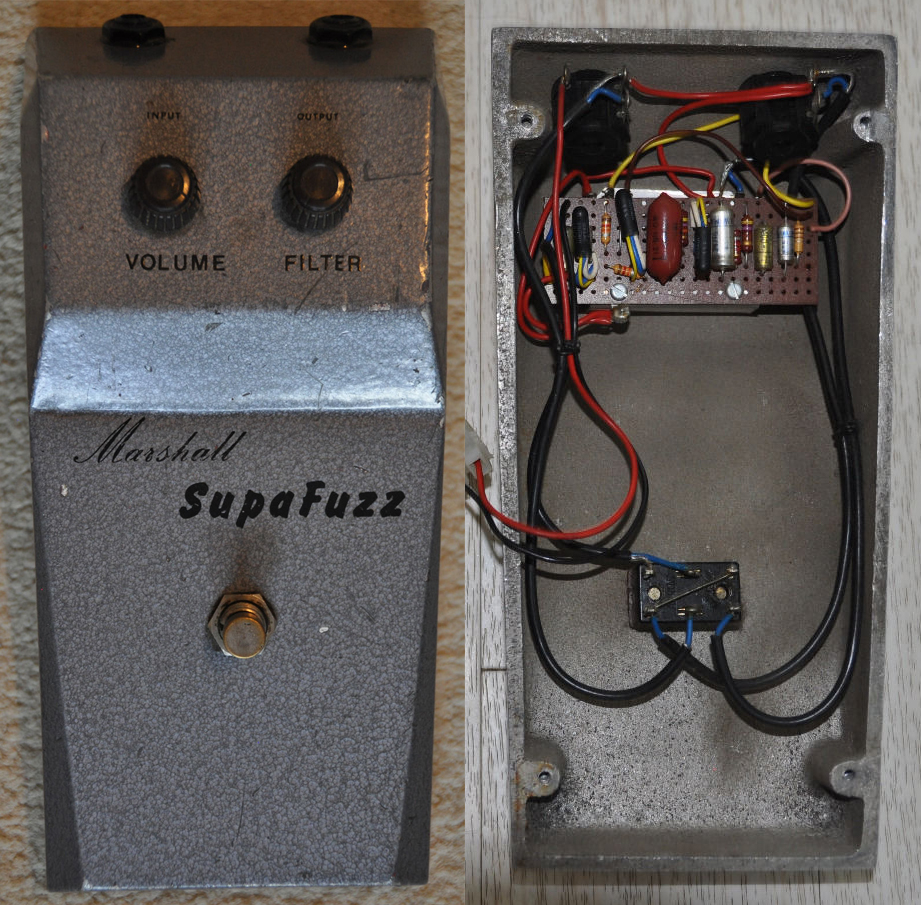

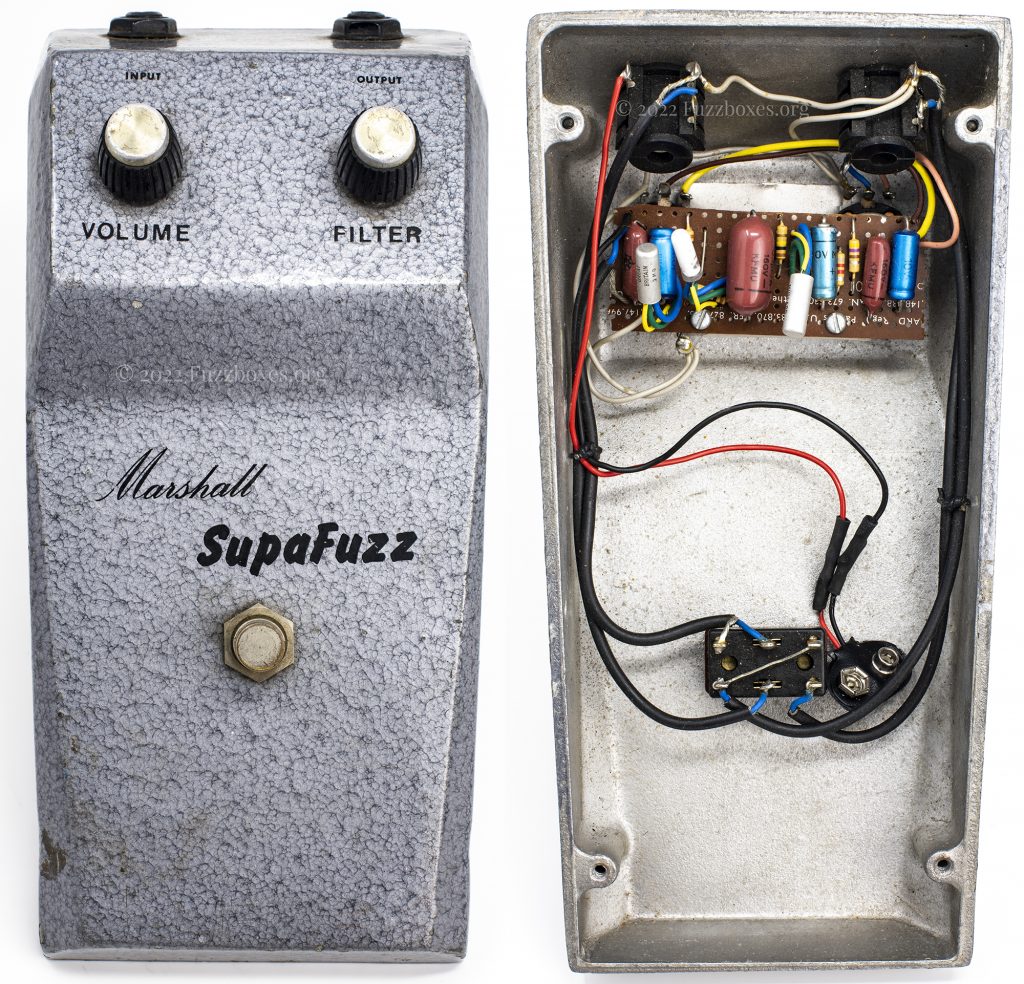
It wasn’t long into the production of the Marshall SupaFuzz that Sola Sound changed the circuit design of the model, and started building the pedals using the same circuit topology as the pedals they were already supplying to companies like Rotosound and Dallas. These SupaFuzzes were built with a completely different circuit to the earlier ‘SupaFuzz MKI’, but this newer circuit design became what is now understood to be the model’s ‘conventional’ circuit: the Tone Bender MKII.
It has been theorised that Marshall, themselves, perhaps may have preferred the sound of the Tone Bender MKII circuit over the earlier MKI circuit, but there is no evidence to substantiate this yet. The general timeline of the development of Sola Sound fuzz boxes in 1966 is also still somewhat murky, but it is distinctly possible that the ‘SupaFuzz MKI’ predated the development of the Tone Bender MKII circuit, and that once the MKII came about, it was simply convenient for the builder(s) to use the same circuitry for all of Sola Sound’s different fuzz boxes.
The change from the MKI circuit, in the SupaFuzz, to the MKII likely happened in 1966 (when Sola Sound were already advertising their own formally-branded version of the MKII in the press4). This is because early SupaFuzz pedals with the Tone Bender MKII circuit featured a similar selection of parts as other early versions of the MKII circuit, and were also still built in the same sand cast enclosures as many of the ‘Supa MKI’ pedals, with the volume & “filter” knobs positioned closer together (as seen in the first of the three photos above). Marshall SupaFuzzes with the MKI & MKII circuits may have even been built by Sola Sound alongside each other for a brief period of time.
The earliest of the SupaFuzzes that came with Tone Bender MKII circuits (built in around 1966, with both ‘narrow’ and the conventional ‘wider’ knob placements) featured the gold-topped Marshall knobs. By 1967, however, Sola Sound were fitting SupaFuzzes with taller, silver-topped control knobs. These silver-topped knobs were the same style that Sola Sound would go onto use for their various other effects pedals (including the Colorsound range in the 1970s).
Sola Sound’s version of the Marshall SupaFuzz (with the Tone Bender MKII circuit) was built in relatively large quantities between 1966-1968, and over the course of that roughly two-year period, the selection of components used for their pedals gradually shifted. Early SupaFuzzes (with both MKI and MKII circuits) featured Mullard OC75 transistors; SupaFuzzes built in 1967 went through alternating periods of using Impex S3-1T & OC75 transistors; and the youngest of the Sola Sound-built Marshall SupaFuzzes, c. 1968, came with the now-illustrious Mullard OC81D transistors. Tone Benders built by Sola Sound during that period for other companies (such as Vox & Rotosound) followed similar patterns of changes in parts selection.
The last of the three images above shows a late-production (Sola Sound-built) Marshall SupaFuzz, built with the OC81D Tone Bender MKII circuit, which dates to 1968. By the time that this pedal was built, Sola Sound had apparently adjusted the kerning of the graphics, which resulted in the the ‘SupaFuzz’ lettering appearing more compact than on earlier editions of the pedal.
1968-c. 1973: The Marshall era
By August of 1968, Marshall had taken over production of the SupaFuzz from Sola Sound.5 Their product, however, remained functionally the same. Marshall had their own cast aluminium enclosures manufactured, and these new cases had softer edges than the Olivetti-inspired Sola Sound version of the SupaFuzz, but were visually very much reminiscent of the original pedal. Marshall even started fitting their gold-topped control knobs to the SupaFuzz, once again.
Marshall’s own version of the SupaFuzz featured the same Tone Bender MKII circuit as the SupaFuzz that Sola Sound were previously supplying the company with. Unsurprisingly, as a result, Marshall’s pedal produced a very similar sound, despite being made by different people.
Date codes on surviving SupaFuzzes reveal that Marshall was still housing the circuits in the screen-printed enclosures until 1970. Both pedals pictured above were, according to date codes on potentiometers, not built until the 1970s.
At some point, in the early 1970s, Marshall updated the enclosures for the SupaFuzz. This newer version featured embossed lettering, as pictured, which replaced the black, printed text.
The electronic circuit remained the same, although at some point during this final phase of the SupaFuzz’s production, the design of the printed circuit board changed slightly, to accommodate the two potentiometers that were eventually being soldered directly to the board.
Date codes on the potentiometers of these ’embossed’ SupaFuzzes prove that the model was still in production by 1973. Contrary to what vintage pedal dealers & resellers often proclaim, the Marshall SupaFuzzes in the ’embossed lettering’ enclosure weren’t built until the 1970s.
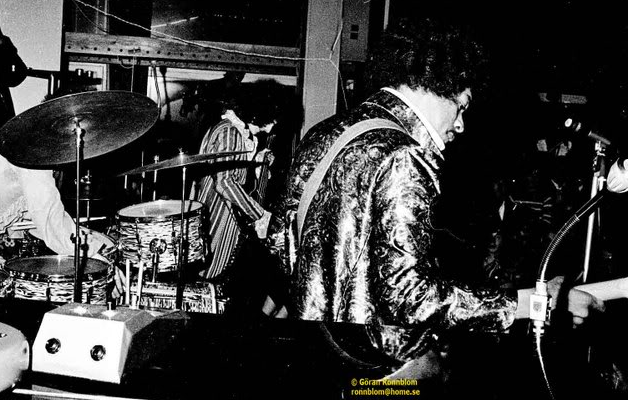
Share your fuzz!
I welcome any comments, feedback, queries & corrections in relation to the Fuzzboxes.org project. Please get in touch via this contact form (or on the ‘contact‘ page).
Much of our understanding of the development of 1960s fuzz boxes comes from analysis of surviving pedals themselves, and so photos of pedals belonging to readers are particularly useful in furthering this research.
If you would like to contribute pictures of 1960s-era guitar effects to Fuzzboxes.org, then feel free to send in any pictures via the uploader below. Photos are greatly appreciated, and any submissions are not published on this website without advance agreement with the contributor.
- Guitarist, “Bend it like Beck can”, November 2009, p. 64
- Birnbaum, Larry (2012), Before Elvis: The Prehistory of Rock ‘n’ Roll, Scarecrow Press
- Hurst, Gary, SupaFuzzes Detailed tech Discussions.MOV. [YouTube], uploaded by Graham Green, 7th May 2011, https://www.youtube.com/watch?v=W93Y_SubJjQ
- Beat Instrumental, November 1966, p. 4
- Beat Instrumental, October 1968, p. 25
